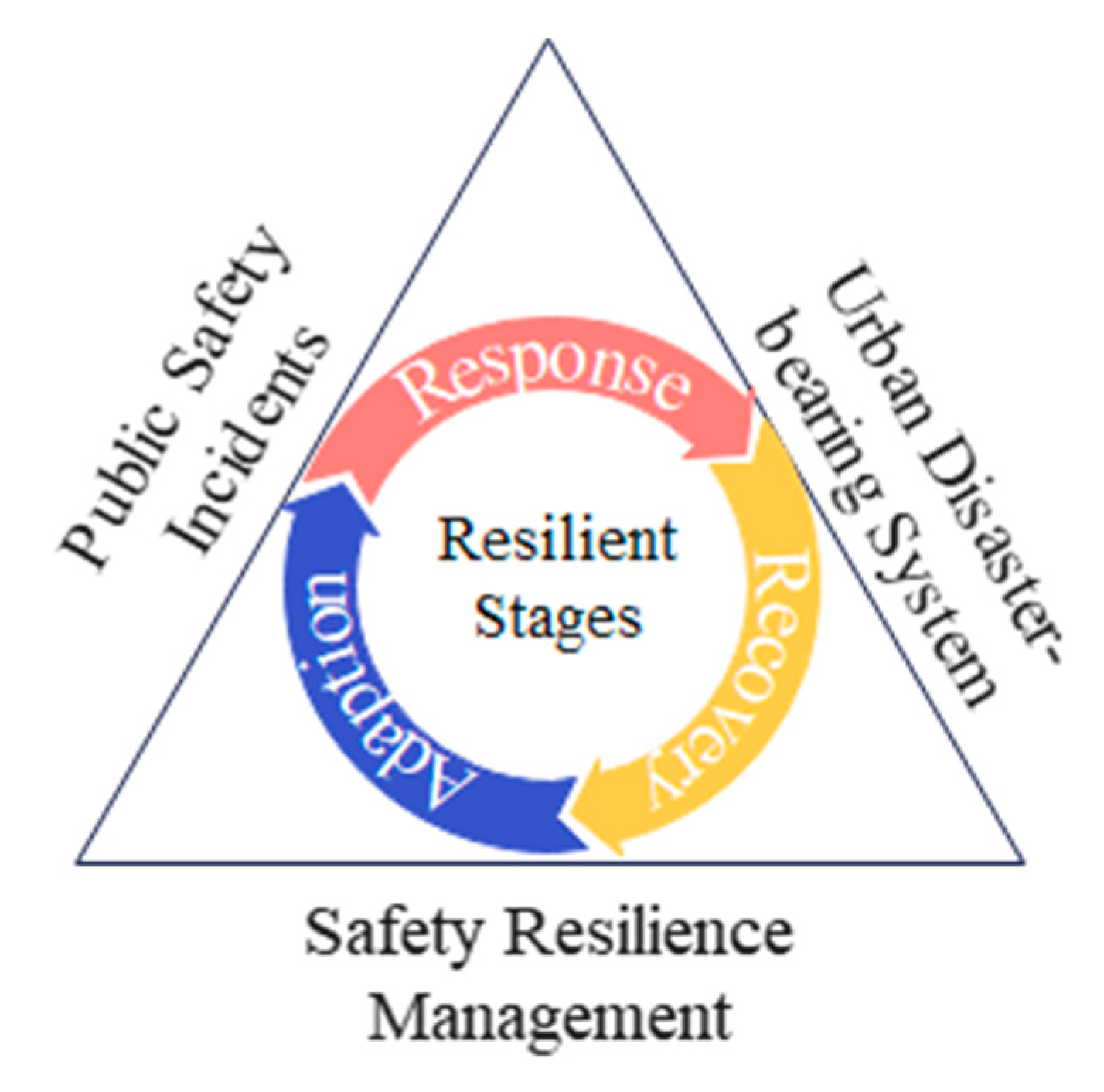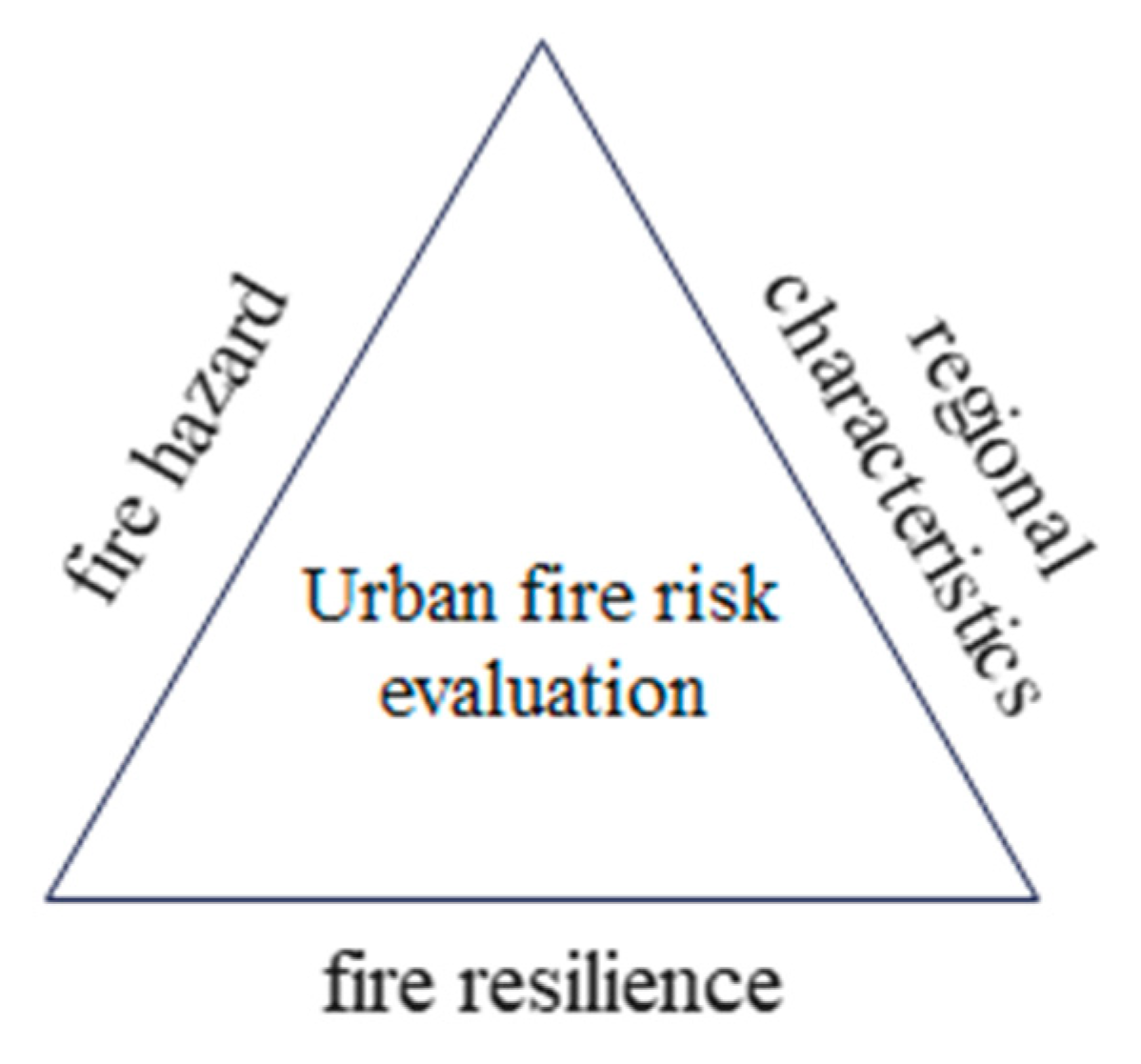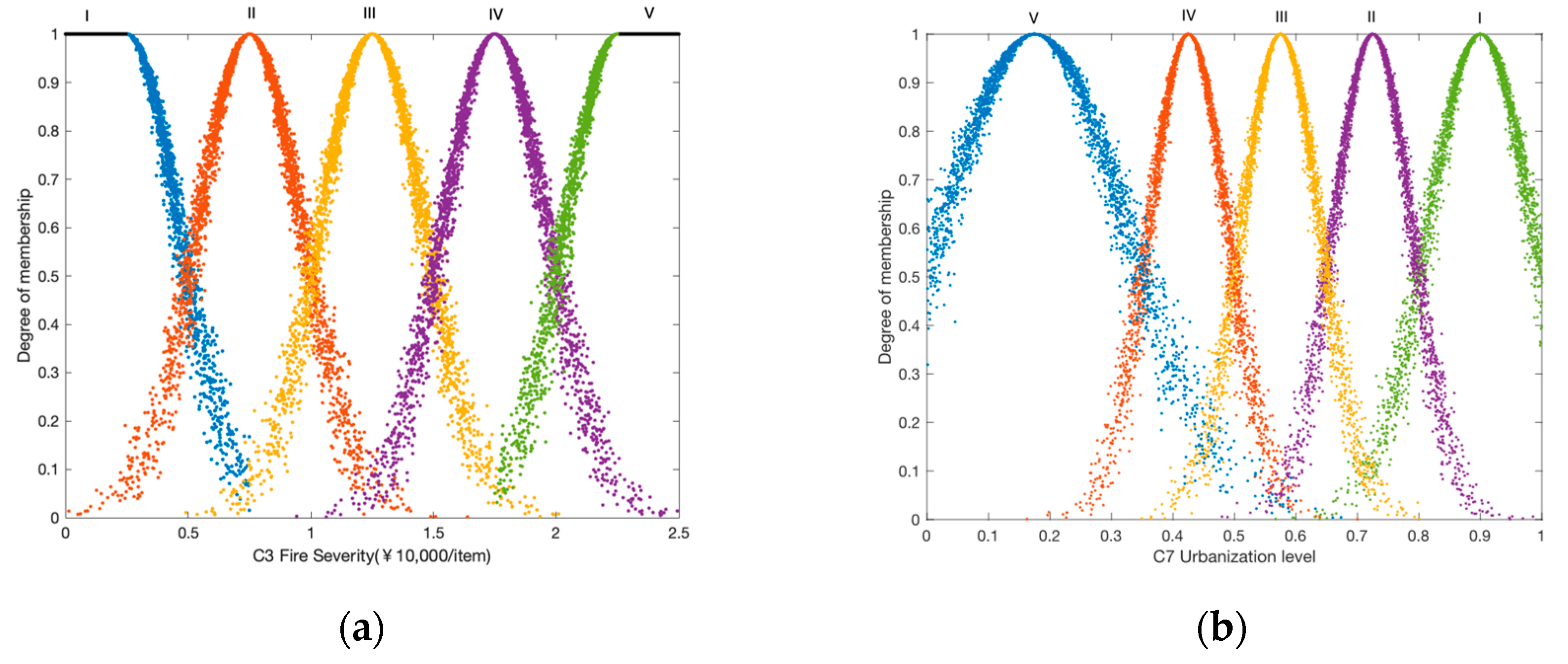Evaluating Urban Fire Risk Based on Entropy-Cloud Model Method Considering Urban Safety Resilience
Abstract
:1. Introduction
2. Urban Safety Resilience
2.1. Concept of Urban Safety Resilience
2.2. Urban Safety Resilience Models
3. Model and Methods
3.1. Fire Risk Evaluation Model Based on Safety Resilience
3.2. Fire Risk Evaluation Index System
3.2.1. Index System Establishment
3.2.2. Criteria of Risk Level
3.3. Entropy-Cloud Model Risk Evaluation Method
3.3.1. Entropy Weight Method
- Raw data processing
- 2.
- Standardization of data matrix
- 3.
- Calculation of the indicators’ entropy
- 4.
- Calculation of the indicators’ entropy weight
3.3.2. Cloud Model Method
- Generate a normal random number with expectation and variance .
- Generate a random number with expectation and variance .
- Calculate the membership of to the qualitative concept, in the traditional cloud model, when obeying the normal distribution:
- 4.
- Repeat the above steps times to obtain a cloud consisting of cloud droplets of .
3.3.3. Risk Evaluation Steps
4. Case Study
4.1. Calculation of Weights
4.2. Determination of the Standard Cloud
4.3. Risk Evaluation Results and Analysis
5. Discussion and Conclusions
Author Contributions
Funding
Data Availability Statement
Conflicts of Interest
References
- Zhang, X.; Yao, J.; Sila-Nowicka, K. Exploring Spatiotemporal Dynamics of Urban Fires: A Case of Nanjing, China. ISPRS Int. Geo-Inf. 2018, 7, 7. [Google Scholar] [CrossRef]
- Turner, S.L.; Johnson, R.D.; Weightman, A.L.; Rodgers, S.E.; Arthur, G.; Bailey, R.; Lyons, R.A. Risk Factors Associated with Unintentional House Fire Incidents, Injuries and Deaths in High-Income Countries: A Systematic Review. Inj. Prev. 2017, 23, 131–137. [Google Scholar] [CrossRef] [PubMed]
- Jennings, C.R. Social and Economic Characteristics as Determinants of Residential Fire Risk in Urban Neighborhoods: A Review of the Literature. Fire Saf. J. 2013, 62, 13–19. [Google Scholar] [CrossRef]
- Hu, J.; Shu, X.; Xie, S.; Tang, S.; Wu, J.; Deng, B. Socioeconomic Determinants of Urban Fire Risk: A City-Wide Analysis of 283 Chinese Cities from 2013 to 2016. Fire Saf. J. 2019, 110, 102890. [Google Scholar] [CrossRef]
- Liu, Z.-G.; Li, X.-Y.; Jomaas, G. Effects of Governmental Data Governance on Urban Fire Risk: A City-Wide Analysis in China. Int. J. Disaster Risk Reduct. 2022, 78, 103138. [Google Scholar] [CrossRef]
- Zhang, Y.; Geng, P.; Sivaparthipan, C.B.; Muthu, B.A. Big Data and Artificial Intelligence Based Early Risk Warning System of Fire Hazard for Smart Cities. Sustain. Energy Technol. Assess. 2021, 45, 100986. [Google Scholar] [CrossRef]
- Shaham, Y.; Benenson, I. Modeling Fire Spread in Cities with Non-Flammable Construction. Int. J. Disaster Risk Reduct. 2018, 31, 1337–1353. [Google Scholar] [CrossRef]
- Wang, J.; Liu, H.; An, S.; Cui, N. A New Partial Coverage Locating Model for Cooperative Fire Services. Inform. Sci. 2016, 373, 527–538. [Google Scholar] [CrossRef]
- Burby, R.J.; Deyle, R.E.; Godschalk, D.R.; Olshansky, R.B. Creating Hazard Resilient Communities through Land-Use Planning. Nat. Hazards Rev. 2000, 1, 99–106. [Google Scholar] [CrossRef]
- Anelli, D.; Tajani, F.; Ranieri, R. Urban Resilience against Natural Disasters: Mapping the Risk with an Innovative Indicators-Based Assessment Approach. J. Clean. Prod. 2022, 371, 133496. [Google Scholar] [CrossRef]
- Xu, H.; Xue, B. Key Indicators for the Resilience of Complex Urban Public Spaces. J. Build. Eng. 2017, 12, 306–313. [Google Scholar] [CrossRef]
- Holling, C.S. Resilience and Stability of Ecological Systems. Ann. Rev. Ecol. Syst. 1973, 4, 1–23. [Google Scholar] [CrossRef]
- Desouza, K.C.; Flanery, T.H. Designing, Planning, and Managing Resilient Cities: A Conceptual Framework. Cities 2013, 35, 89–99. [Google Scholar] [CrossRef]
- Meerow, S.; Newell, J.P.; Stults, M. Defining Urban Resilience: A Review. Landsc. Urban Plan. 2016, 147, 38–49. [Google Scholar] [CrossRef]
- Marana, P.; Labaka, L.; Mari Sarriegi, J. A Framework for Public-Private-People Partnerships in the City Resilience-Building Process. Saf. Sci. 2018, 110, 39–50. [Google Scholar] [CrossRef]
- Fan, W. Modernizing Public Safety Governance with the Construction of a Safe and Resilient City. Frontiers 2022, z1, 14–24. (In Chinese). [Google Scholar] [CrossRef]
- Chen, C.; Xu, L.; Zhao, D.; Xu, T.; Lei, P. A New Model for Describing the Urban Resilience Considering Adaptability, Resistance and Recovery. Saf. Sci. 2020, 128, 104756. [Google Scholar] [CrossRef]
- Bruneau, M.; Chang, S.E.; Eguchi, R.T.; Lee, G.C.; O’Rourke, T.D.; Reinhorn, A.M.; Shinozuka, M.; Tierney, K.; Wallace, W.A.; von Winterfeldt, D. A Framework to Quantitatively Assess and Enhance the Seismic Resilience of Communities. Earthq. Spectra 2003, 19, 733–752. [Google Scholar] [CrossRef]
- Liu, L.; Lei, Y.; Fath, B.D.; Hubacek, K.; Yao, H.; Liu, W. The Spatio-Temporal Dynamics of Urban Resilience in China’s Capital Cities. J. Clean. Prod. 2022, 379, 134400. [Google Scholar] [CrossRef]
- Huang, H.; Li, R.; Wang, W.; Qin, T.; Zhou, R.; Fan, W. Concepts, Models, and Indicator Systems for Urban Safety Resilience: A Literature Review and an Exploration in China. J. Saf. Sci. Resil. 2023, 4, 30–42. [Google Scholar] [CrossRef]
- National Fire and Rescue Administration. Available online: https://www.119.gov.cn/gk/sjtj/2022/13721.shtml (accessed on 20 December 2022).
- Shannon, C.E. A Mathematical Theory of Communication. Bell Syst. Tech. J. 1948, 27, 379–423. [Google Scholar] [CrossRef]
- Wu, D.; Li, Z. Work Safety Success Theory Based on Dynamic Safety Entropy Model. Saf. Sci. 2019, 113, 438–444. [Google Scholar] [CrossRef]
- Yang, M. System Safety Assessment Using Safety Entropy. J. Loss Prev. Process Ind. 2020, 66, 104174. [Google Scholar] [CrossRef]
- Li, D.; Liu, C.; Gan, W. A New Cognitive Model: Cloud Model. Int. J. Intell. Syst. 2009, 24, 357–375. [Google Scholar] [CrossRef]
- Tan, F.; Wang, J.; Jiao, Y.-Y.; Ma, B.; He, L. Suitability Evaluation of Underground Space Based on Finite Interval Cloud Model and Genetic Algorithm Combination Weighting. Tunn. Undergr. Sp. Technol. 2021, 108, 103743. [Google Scholar] [CrossRef]
- Zhang, C.; Tian, G.; Fathollahi-Fard, A.M.; Wang, W.; Wu, P.; Li, Z. Interval-Valued Intuitionistic Uncertain Linguistic Cloud Petri Net and Its Application to Risk Assessment for Subway Fire Accident. IEEE Trans. Autom. Sci. Eng. 2022, 19, 163–177. [Google Scholar] [CrossRef]
- Zhao, J.; Tian, J.; Meng, F.; Zhang, M.; Wu, Q. Safety Assessment Method for Storage Tank Farm Based on the Combination of Structure Entropy Weight Method and Cloud Model. J. Loss Prev. Process Ind. 2022, 75, 104709. [Google Scholar] [CrossRef]
- Changsha Municipal People’s Government. Available online: http://www.changsha.gov.cn/zfxxgk/ (accessed on 20 December 2022).
- Ministry of Public Security Fire Service Bureau. China Fire Yearbook; Yunnan Personnel Press: Kunming, China, 2013. (In Chinese). [Google Scholar]
- HuNan Fire and Rescue Department. Available online: http://www.hn119.gov.cn/ (accessed on 20 December 2022).
- Emergency Plan for Fire Accidents in Hunan Province, HuNan Municipal People’s Government. Available online: http://www.hunan.gov.cn/hnszf/xxgk/wjk/szfbgt//201802/t20180205_4945294.html (accessed on 13 December 2022).
- Xiao, H.; Zhou, Y.; Zhang, H. GIS-Based Fire Risk Assessment and Fire Station Site Selection—Taking Dujiangyan City as An Example. In Proceedings of the 2020 International Conference on Urban Construction and Management Engineering, Taiyuan, China, 16–18 October 2020; Volume 608, p. 012008. [Google Scholar] [CrossRef]
- Nuthammachot, N.; Stratoulias, D. A GIS- and AHP-Based Approach to Map Fire Risk: A Case Study of Kuan Kreng Peat Swamp Forest, Thailand. Geocarto Int. 2021, 36, 212–225. [Google Scholar] [CrossRef]




| Perspective | Indicators | Indicator Direction |
|---|---|---|
| Fire risk | C1 Fire hazard places | Positive |
| C2 Important populations distribution | Positive | |
| C3 Fire severity | Positive | |
| C4 Historical fire casualties | Negative | |
| Regional characteristics | C5 Regional population | Positive |
| C6 Economic status | Positive | |
| C7 Urbanization level | Negative | |
| C8 Seasonal influence | Positive | |
| Fire resilience | C9 Fire stations construction | Negative |
| C10 Firefighting capacity | Negative | |
| C11 Safety supervision | Negative | |
| C12 Danger management | Negative |
| Indicator Code | Indicators | 2013 | 2014 | 2015 | 2016 | 2017 | 2018 | 2019 |
|---|---|---|---|---|---|---|---|---|
| C1 | Fire hazard places | 0.154 | 0.171 | 0.172 | 0.193 | 0.194 | 0.206 | 0.209 |
| C2 | Important populations distribution | 0.194 | 0.258 | 0.366 | 0.418 | 0.371 | 0.382 | 0.397 |
| C3 | Fire severity | 1.813 | 1.375 | 1.465 | 1.253 | 3.186 | 2.559 | 2.440 |
| C4 | Historical fire loss | 0.688 | 2.078 | 1.870 | 1.931 | 1.964 | 1.837 | 1.913 |
| C5 | Regional population | 609.349 | 616.952 | 627.103 | 645.110 | 668.138 | 688.102 | 708.337 |
| C6 | Economic status | 3.366 | 3.683 | 3.996 | 4.329 | 4.695 | 5.079 | 5.521 |
| C7 | Urbanization level | 47.960 | 49.280 | 50.890 | 52.750 | 54.620 | 56.020 | 57.220 |
| C8 | Seasonal influence | 54.657 | 63.345 | 57.952 | 58.543 | 59.988 | 60.064 | 59.192 |
| C9 | Fire stations construction | 0.023 | 0.029 | 0.030 | 0.031 | 0.032 | 0.038 | 0.041 |
| C10 | Firefighting capability | 5.206 | 4.997 | 5.749 | 9.316 | 10.354 | 11.418 | 12.509 |
| C11 | Safety supervision | 13.751 | 105.681 | 153.324 | 172.969 | 105.100 | 124.225 | 39.171 |
| C12 | Danger management | 0.822 | 4.824 | 0.944 | 2.653 | 5.364 | 11.321 | 14.729 |
| Indicator | Information Entropy | Redundant Degree | Entropy Weight |
|---|---|---|---|
| C1 | 0.877 | 0.123 | 0.062 |
| C2 | 0.896 | 0.104 | 0.052 |
| C3 | 0.773 | 0.227 | 0.114 |
| C4 | 0.665 | 0.335 | 0.169 |
| C5 | 0.801 | 0.199 | 0.100 |
| C6 | 0.846 | 0.154 | 0.078 |
| C7 | 0.840 | 0.160 | 0.081 |
| C8 | 0.896 | 0.104 | 0.053 |
| C9 | 0.872 | 0.128 | 0.065 |
| C10 | 0.833 | 0.167 | 0.084 |
| C11 | 0.832 | 0.168 | 0.084 |
| C12 | 0.885 | 0.115 | 0.058 |
| Indicator | Risk Level | ||||
|---|---|---|---|---|---|
| I | II | III | IV | V | |
| C1 | 0–0.1 | 0.1–0.4 | 0.4–0.7 | 0.7–1 | >1 |
| C2 | 0–0.1 | 0.1–0.4 | 0.4–0.7 | 0.7–1 | >1 |
| C3 | 0–0.5 | 0.5–1 | 1–1.5 | 1.5–2 | >2 |
| C4 | >2.5 | 2.5–2 | 2–1.5 | 1.5–1 | 0–1 |
| C5 | <500 | 500–1000 | 1000–1500 | 1500–2000 | >2000 |
| C6 | <3.5 | 3.5–5 | 5–6.5 | 6.5–8 | >8 |
| C7 | 0.8–1 | 0.8–0.65 | 0.65–0.5 | 0.5–0.35 | 0.35–0 |
| C8 | 0.45–0.5 | 0.5–0.52 | 0.52–0.55 | 0.55–0.6 | >0.6 |
| C9 | >0.07 | 0.07–0.06 | 0.06–0.04 | 0.04–0.02 | 0.02–0 |
| C10 | >20 | 20–15 | 15–10 | 10–5 | 0–5 |
| C11 | >160 | 160–120 | 120–80 | 80–40 | 0–40 |
| C12 | >10 | 10–7 | 7–4 | 4–1 | 0–1 |
| Indicator | Cloud Model Numerical Characteristics | ||||
|---|---|---|---|---|---|
| I | II | III | IV | V | |
| C1 | (0.050, 0.042, 0.004) | (0.250, 0.127, 0.013) | (0.600, 0.127, 0.013) | (0.850, 0.127, 0.013) | (1.150, 0.127, 0.013) |
| C2 | (0.050, 0.042, 0.004) | (0.250, 0.127, 0.013) | (0.600, 0.127, 0.013) | (0.850, 0.127, 0.013) | (1.150, 0.127, 0.013) |
| C3 | (0.250, 0.212, 0.021) | (0.750, 0.212, 0.021) | (1.250, 0.212, 0.021) | (1.750, 0.212, 0.021) | (2.250, 0.212, 0.021) |
| C4 | (2.750, 0212, 0.021) | (2.250, 0.212, 0.021) | (1.750, 0.212, 0.021) | (1.250, 0.212, 0.021) | (0.500, 0.425, 0.042) |
| C5 | (250.000, 212.314, 21.231) | (750.000, 212.314, 21.231) | (1250.000, 212.314, 21.231) | (1750.000, 212.314, 21.231) | (2250.000, 212.314, 21.231) |
| C6 | (2.750, 0.637, 0.064) | (3.609, 0.637, 0.064) | (4.883, 0.637, 0.064) | (6.157, 0.637, 0.064) | (8.750, 0.637, 0.064) |
| C7 | (0.900, 0.085, 0.008) | (0.725, 0.064, 0.006) | (0.575, 0.064, 0.006) | (0.425, 0.064, 0.006) | (0.175, 0.149, 0.015) |
| C8 | (0.475, 0.021, 0.002) | (0.510, 0.008, 0.001) | (0.535, 0.013, 0.001) | (0.575, 0.021, 0.002) | (0.625, 0.021, 0.002) |
| C9 | (0.075, 0.004, 0.000) | (0.065, 0.004, 0.000) | (0.050, 0.008, 0.001) | (0.030, 0.008, 0.001) | (0.010, 0.008, 0.001) |
| C10 | (22.500, 2.123, 0.212) | (17.500, 2.123, 0.212) | (12.500, 2.123, 0.212) | (7.500, 2.123, 0.212) | (2.500, 2.123, 0.212) |
| C11 | (180.000, 16.985, 1.699) | (140.000, 16.985, 1.699) | (100.000, 16.985, 1.699) | (60.000, 16.985, 1.699) | (20.000, 16.985, 1.699) |
| C12 | (11.500, 1.274, 0.127) | (8.500, 1.274, 0.127) | (5.500, 1.274, 0.127) | (2.500, 1.274, 0.127) | (0.500, 0.425, 0.042) |
Disclaimer/Publisher’s Note: The statements, opinions and data contained in all publications are solely those of the individual author(s) and contributor(s) and not of MDPI and/or the editor(s). MDPI and/or the editor(s) disclaim responsibility for any injury to people or property resulting from any ideas, methods, instructions or products referred to in the content. |
© 2023 by the authors. Licensee MDPI, Basel, Switzerland. This article is an open access article distributed under the terms and conditions of the Creative Commons Attribution (CC BY) license (https://creativecommons.org/licenses/by/4.0/).
Share and Cite
Bai, M.; Liu, Q. Evaluating Urban Fire Risk Based on Entropy-Cloud Model Method Considering Urban Safety Resilience. Fire 2023, 6, 62. https://doi.org/10.3390/fire6020062
Bai M, Liu Q. Evaluating Urban Fire Risk Based on Entropy-Cloud Model Method Considering Urban Safety Resilience. Fire. 2023; 6(2):62. https://doi.org/10.3390/fire6020062
Chicago/Turabian StyleBai, Minghao, and Qiong Liu. 2023. "Evaluating Urban Fire Risk Based on Entropy-Cloud Model Method Considering Urban Safety Resilience" Fire 6, no. 2: 62. https://doi.org/10.3390/fire6020062
APA StyleBai, M., & Liu, Q. (2023). Evaluating Urban Fire Risk Based on Entropy-Cloud Model Method Considering Urban Safety Resilience. Fire, 6(2), 62. https://doi.org/10.3390/fire6020062







